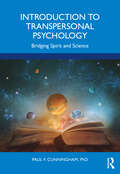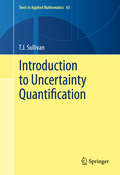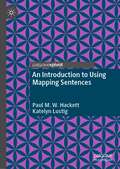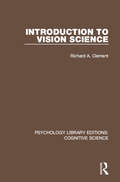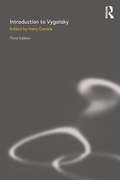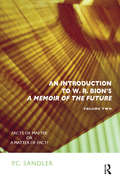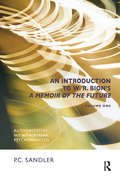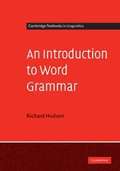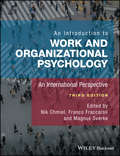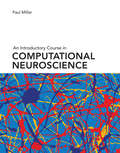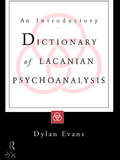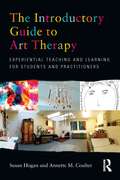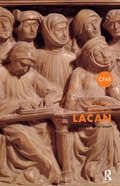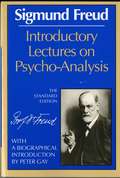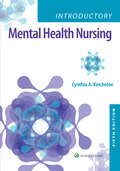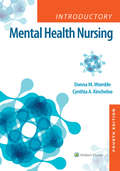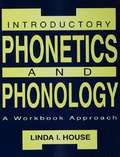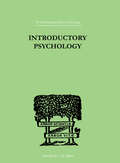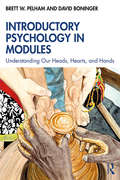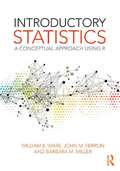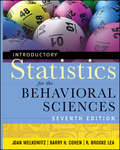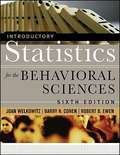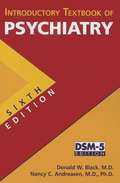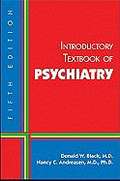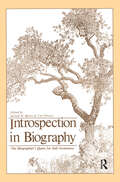- Table View
- List View
Introduction to Transpersonal Psychology: Bridging Spirit and Science
by Paul F. Cunningham, Ph.D.Introduction to Transpersonal Psychology: Bridging Spirit and Science provides an accessible and engaging introduction to this complex and evolving field. Adopting a modular approach, the book systematically relates key themes of Transpersonal Psychology to three major areas within psychology: general psychology, experimental psychology, and clinical psychology. Covering a wide range of topics including transpersonal states of consciousness, biological foundations, research methods, and cognition, the book also features extensive discussion of transpersonal theorists and the impact of their work on our understanding of psychological concepts. The book also introduces contemporary developments in the field and anticipates future advances such as feminist perspectives and cross-cultural approaches alongside practical experiments designed to give transpersonal theories and concepts psychological roots. A critical evaluation of both mainstream and transpersonal theories and research is applied throughout to foster analytical skills and encourage critical and scientific thinking about humanity’s nature as spiritual creatures and ways to educate for personal and social transformation. Accompanied by an online instructor’s manual, this book will be an essential companion for all students of Transpersonal or Humanistic Psychology, or those interested in applying transpersonal ideas to mainstream psychological research.
Introduction to Uncertainty Quantification
by T. J. SullivanThis text provides a framework in which the main objectives of the field of uncertainty quantification (UQ) are defined and an overview of the range of mathematical methods by which they can be achieved. Complete with exercises throughout, the book will equip readers with both theoretical understanding and practical experience of the key mathematical and algorithmic tools underlying the treatment of uncertainty in modern applied mathematics. Students and readers alike are encouraged to apply the mathematical methods discussed in this book to their own favorite problems to understand their strengths and weaknesses, also making the text suitable for a self-study. Uncertainty quantification is a topic of increasing practical importance at the intersection of applied mathematics, statistics, computation and numerous application areas in science and engineering. This text is designed as an introduction to UQ for senior undergraduate and graduate students with a mathematical or statistical background and also for researchers from the mathematical sciences or from applications areas who are interested in the field. T. J. Sullivan was Warwick Zeeman Lecturer at the Mathematics Institute of the University of Warwick, United Kingdom, from 2012 to 2015. Since 2015, he is Junior Professor of Applied Mathematics at the Free University of Berlin, Germany, with specialism in Uncertainty and Risk Quantification.
An Introduction to Using Mapping Sentences
by Paul M. Hackett Katelyn LustigThis book acts as an introductory guide to understanding and using the mapping sentence as a tool in social science and humanities research. The book fills the need for a concise text that simply instructs how and when to use a mapping sentence and provides practical examples. Mapping sentences are a major research component and tool of facet theory. The book begins by covering the background to mapping sentence, including the philosophy and theory underpinning it. The following chapter discuss what mapping sentence is, what different kinds of mapping sentences exist, and knowing when and which to use it in a given situation. The book then moves into describing how to write a mapping sentence and how to analyse the information gained from mapping sentence research. It ends with a consideration of the future developments of mapping sentences and their applications across the social sciences and humanities, including in particular psychology, marketing, behavioural biology, art and health.
Introduction to Vision Science (Psychology Library Editions: Cognitive Science)
by Richard A. ClementDifferent animals have different visual systems and so presumably have different ways of seeing. How does the way in which we see depend on the optical, neural and motor components of our visual systems? Originally published in 1993, the mathematical tools needed to answer this question are introduced in this book. Elementary linear algebra is used to describe the transformations of the stimulus that occur in the formation of the optical, neural and motor images in the human visual system. The distinctive feature of the approach is that transformations are specified with enough rigour for readers to be able to set up their own models and generate predictions from them. Underlying the approach of this book is the goal of providing a self-contained source for the derivation of the basic equations of vision science. An introductory section on vector and matrix algebra covers the mathematical techniques which are applied to both sensory and motor aspects of the visual system, and the intervening steps in the mathematical arguments are given in full, in order to make the derivation of the equations easier to follow. A subsidiary goal of this book is to demonstrate the utility of current desktop computer packages which make the application of mathematics very easy. All the numerical results were produced using only a spreadsheet or mathematics package, and example calculations are included in the text.
Introduction to Vygotsky
by Harry DanielsThis thoroughly updated third edition provides students with an accessible overview of Vygotsky’s work, combining reprints of key journal and text articles with rich editorial commentary. Lev Vygotsky provided the twentieth century with an enticing mix of intellectual traditions within an attempt to provide an account of the social formation of the mind. His legacy is an exciting, but at times challenging fusion of ideas. Retaining a multi-disciplinary theme, Introduction to Vygotsky, 3rd edition begins with a review of current interpretations of Vygotksy’s original work. Harry Daniels goes on to consider the development of Vygotsky’s work against a backdrop of political turmoil in the developing USSR. Major elements explored within the volume include the use of the 'culture' concept in social development theory, the development of means of describing social life, the concept of mediation, and implications for teaching, learning and assessment This book will be essential reading for Vygotskian students in developmental psychology, education and social sciences, as well as to students on specialised courses on cultural, cross-cultural and socio-cultural psychology, philosophical psychology, philosophy of science, history of psychology and Soviet/Russian history.
An Introduction to W.R. Bion's 'A Memoir of the Future': Facts of Matter or a Matter of Fact?
by P.C. SandlerIn the last years of his life Bion gathered unusual manuscripts handwritten in his tidy lettering that assumed the form of a trilogy. Finely typed and edited by his dedicated wife, they were named A Memoir of the Future. Many of the themes of this book were already evident in Transformations and Attention and Interpretation. These earlier books provide many of the theories whose practical counterpart finally found a form in the trilogy: as Bion himself noted, "the criteria for a psychoanalytic paper are that it should stimulate in the reader the emotional experience that the writer intends, that its power to stimulate should be durable, and that the emotional experience thus stimulated should be an accurate representation of the psychoanalytic experience that stimulated the writer in first place." In this second volume of a much needed introduction to Bion's last work, A Memoir of the Future, Paulo Cesar Sandler continues his detailed and insightful "prelude" to a work many readers have found "obscure, complicated and difficult".
An Introduction to W.R. Bion's 'A Memoir of the Future': Authoritative, Not Authoritarian, Psychoanalysis
by P.C. SandlerIn the last years of his life Bion gathered unusual manuscripts handwritten in his tidy lettering that assumed the form of a trilogy. Finely typed and edited by his dedicated wife, they were named A Memoir of the Future. Many of the themes of this book were already evident in Transformations and Attention and Interpretation. These earlier books provide many of the theories whose practical counterpart finally found a form in the trilogy: as Bion himself noted, "the criteria for a psychoanalytic paper are that it should stimulate in the reader the emotional experience that the writer intends, that its power to stimulate should be durable, and that the emotional experience thus stimulated should be an accurate representation of the psychoanalytic experience that stimulated the writer in first place." Was Bion true to his word? It is perhaps left to the reader to answer this question. The present book is an attempt to indicate the view that Bion's attempt was to present the burning flame itself - rather than presenting static photographs of the fire.
An Introduction to Word Grammar
by Richard HudsonWord grammar is a theory of language structure and is based on the assumption that language, and indeed the whole of knowledge, is a network, and that virtually all of knowledge is learned. It combines the psychological insights of cognitive linguistics with the rigour of more formal theories. This textbook spans a broad range of topics from prototypes, activation and default inheritance to the details of syntactic, morphological and semantic structure. It introduces elementary ideas from cognitive science and uses them to explain the structure of language including a survey of English grammar.
An Introduction to Work and Organizational Psychology: An International Perspective
by Franco Fraccaroli Magnus Sverke Nik ChmielThis fully updated edition of a best-selling textbook provides the most comprehensive introduction to issues in work and organizational psychology with an international perspective; reflecting current advancements in the workplace, the book brings together the expertise of leading thinkers and practitioners. Fully updated third edition of the best-selling textbook on work and organizational psychology now with an international perspective Presents a solid foundation on a range of core topics including working with technology, the impact on employees when organizations change, and maintaining the work-life balance Updated throughout to include recently emerging themes and current views in the field Includes five new case studies covering age management, diversity at the top, resilience development, respect at work and a strategic approach to improving wellbeing in the workplace Provides instructor and student support includes key studies, research close-ups, discussion points and five extensive case studies
An Introductory Course in Computational Neuroscience (Computational Neuroscience Series)
by Paul MillerA textbook for students with limited background in mathematics and computer coding, emphasizing computer tutorials that guide readers in producing models of neural behavior. This introductory text teaches students to understand, simulate, and analyze the complex behaviors of individual neurons and brain circuits. It is built around computer tutorials that guide students in producing models of neural behavior, with the associated Matlab code freely available online. From these models students learn how individual neurons function and how, when connected, neurons cooperate in a circuit. The book demonstrates through simulated models how oscillations, multistability, post-stimulus rebounds, and chaos can arise within either single neurons or circuits, and it explores their roles in the brain. The book first presents essential background in neuroscience, physics, mathematics, and Matlab, with explanations illustrated by many example problems. Subsequent chapters cover the neuron and spike production; single spike trains and the underlying cognitive processes; conductance-based models; the simulation of synaptic connections; firing-rate models of large-scale circuit operation; dynamical systems and their components; synaptic plasticity; and techniques for analysis of neuron population datasets, including principal components analysis, hidden Markov modeling, and Bayesian decoding. Accessible to undergraduates in life sciences with limited background in mathematics and computer coding, the book can be used in a “flipped” or “inverted” teaching approach, with class time devoted to hands-on work on the computer tutorials. It can also be a resource for graduate students in the life sciences who wish to gain computing skills and a deeper knowledge of neural function and neural circuits.
An Introductory Dictionary of Lacanian Psychoanalysis
by Dylan EvansJacques Lacan's thinking revolutionised the theory and practice of psychoanalysis and had a major impact in fields as diverse as film studies, literary criticism, feminist theory and philosophy. Yet his writings are notorious for their complexity and idiosyncratic style. Emphasising the clinical basis of Lacan's work, An Introductory Dictionary of Lacanian Psychoanalysis is an ideal companion to his ideas for readers in every discipline where his influence is felt. The Dictionary features:* over 200 entries, explaining Lacan's own terminology and his use of common psychoanalytic expressions* details of the historical and institutional context of Lacan's work* reference to the origins of major concepts in the work of Freud, Saussure, Hegel and other key thinkers* a chronology of Lacan's life and works.
The Introductory Guide to Art Therapy: Experiential teaching and learning for students and practitioners
by Susan Hogan Annette M. CoulterThe Introductory Guide to Art Therapy provides a comprehensive and accessible text for art therapy trainees. Susan Hogan and Annette M. Coulter here use their combined clinical experience to present theories, philosophies and methods of working clearly and effectively. The authors cover multiple aspects of art therapy in this overview of practice, from working with children, couples, families and offenders to the role of supervision and the effective use of space. The book addresses work with diverse groups and includes a glossary of key terms, ensuring that complex terminology and theories are clear and easy to follow. Professional and ethical issues are explored from an international perspective and careful attention is paid to the explanation and definition of key terms and concepts. Accessibly written and free from jargon, Hogan and Coulter provide a detailed overview of the benefits and possibilities of art therapy. This book will be an indispensable introductory guide for prospective students, art therapy trainees, teachers, would-be teachers and therapy practitioners. The text will also be of interest to counsellors and other allied health professionals who are interested in the use of visual methods.
Introductory Lectures on Lacan (The Centre for Freudian Analysis and Research Library (CFAR))
by Astrid GessertLacan developed his theory and practice of psychoanalysis on the basis of Freud's original work. In his "return to Freud" he not only elaborated and revised some of Freud's innovative ideas, but turned to important questions and problems in Freud's theory that had remained obscure and unresolved, and provided a new way of articulating these issues and their implication for psychoanalytic theory and practice. This book offers a selection of chapters about some of the fundamental concepts of psychoanalysis. The authors aim to explore the trajectory of the development of these concepts from their original basis in Freud's work to their elaboration by Lacan. The book will be of interest to readers from different backgrounds, including the clinical and academic field, social and cultural studies and the arts, for whom psychoanalytic ideas may be a relatively new field to explore, or who are looking for new perspectives to develop their ideas about psychoanalysis.
Introductory Lectures On Psycho-Analysis
by Sigmund Freud Translated edited by James StracheyFreud approved the overall editorial plan, specific renderings of key words and phrases, and the addition of valuable notes, from bibliographical and explanatory. <P><P>Many of the translations were done by Strachey himself; the rest were prepared under his supervision. The result was to place the Standard Edition in a position of unquestioned supremacy over all other existing versions.
Introductory Mental Health Nursing
by Cynthia A. KincheloeUpdated, easy to read, and designed specifically for today’s LPN/LVN students, Introductory Mental Health Nursing, 5th Edition, makes the realities of mental health nursing approachable and prepares students to confidently manage clients’ mental healthcare needs across a wide range of care settings. This extensively revised 5th Edition delivers clear, comprehensive, clinically relevant information reflecting the care needs of a diverse client population. Powerful built-in study aids strengthen students’ critical thinking and clinical application capabilities to prepare them for any challenge they may encounter.
Introductory Mental Health Nursing
by Donna Womble Cynthia KincheloePublisher's Note: Products purchased from 3rd Party sellers are not guaranteed by the Publisher for quality, authenticity, or access to any online entitlements included with the product. Introductory Mental Health Nursing, 4th Edition Donna Womble, MEd, BS, RN; and Cynthia A. Kincheloe, MSN, BSN, ADN, RN Confidently manage the mental health issues you’ll encounter across a wide range of health care settings. Written specifically for LPN/LVN students, Introductory Mental Health Nursing, 4th Edition, equips you for the challenges of modern mental health nursing with clear, direct, clinically relevant information reflecting the most up-to-date perspectives in the field. This acclaimed text establishes essential groundwork then builds on fundamental concepts to instill a confident understanding of the delivery of mental health care, the nursing process and its relation to mental health, and the management of specific psychiatric disorders to prepare you for success from the classroom to your career. Enhanced! Case applications guide you in applying the nursing process to resolve clinical problems. Updated! Chapter-ending Student Worksheets reinforce key concepts through fill-in-the-blank, matching, and multiple-choice NCLEX®-style questions. At a Glance sections highlight or summarize essential information for stronger recall and retention. Just the Factsentries distill critical details for faster, more efficient review. Mind Jogger critical thinking questions promote deeper understanding. At-A-Glance Senior Focus helps you confidently prepare for the care of older adults or elderly clients. Updated terminology helps you ensure the most effective clinical communication.
Introductory Phonetics and Phonology: A Workbook Approach
by Linda I. HouseSuccess in mastering any language requires knowledge in speaking, reading, and writing the language. The speaking component requires the understanding and use of correct pronunciation, emphasis, and syntactic patterns. The written component requires mastery of the alphabet, spelling, and the ability to write, print, or type the pattern. Very early in the learning process, speakers of the English language become keenly aware of the language's lack of sound to symbol correspondence. To help speech/language researchers, media personnel, individuals learning English as a second language, and others interested in correct pronunciation, the International Phonetic Alphabet (IPA) was devised. Extensively class tested, this book offers a practical understanding approach to phonetics and the IPA in a workbook format. It will be welcomed by professionals, students, and trainees in the fields of communication science, communication disorders, speech pathology, and linguistics.
Introductory Psychology: AN APPROACH FOR SOCIAL WORKERS (International Library Of Psychology Ser.)
by Price-Williams, D RFirst published in 1999. Routledge is an imprint of Taylor & Francis, an informa company.
Introductory Psychology in Modules: Understanding Our Heads, Hearts, and Hands
by Brett Pelham David BoningerIntroductory Psychology in Modules: Understanding Our Heads, Hearts, and Hands is a unique and comprehensive introduction to psychology. It consists of 36 short modules that keep students engaged with humor, a narrative style, and hands-on activities that facilitate interactive learning and critical thinking. Each stand-alone module focuses on a major topic in psychology, from the brain, sensation, memory, and cognition to human development, personality, social psychology, and clinical psychology. The modular format also allows a deep dive into important topics that have less coverage in other introductory psychology textbooks. This includes cross-cultural psychology, stereotypes and discrimination, evolutionary psychology, sex and gender, climate change, health psychology, and sport psychology. This truly modular format – ideal for both face to face and virtual learning – makes it easy for instructors to customize their readings and assign exactly what they wish to emphasize. The book also contains an abundance of pedagogical features, including numerous hands-on activities and/or group discussion activities, multiple-choice practice quizzes, and an instructor exam bank written by the authors. By covering both classic and contemporary topics, this book will delight students and instructors alike. The modular format also makes this a useful supplementary text for classes in nursing, medicine, social work, policing, and sociology.
Introductory Statistics: A Conceptual Approach Using R
by William B. Ware John M. Ferron Barbara M. MillerThis comprehensive and uniquely organized text is aimed at undergraduate and graduate level statistics courses in education, psychology, and other social sciences. A conceptual approach, built around common issues and problems rather than statistical techniques, allows students to understand the conceptual nature of statistical procedures and to focus more on cases and examples of analysis. Wherever possible, presentations contain explanations of the underlying reasons behind a technique. Importantly, this is one of the first statistics texts in the social sciences using R as the principal statistical package. Key features include the following. Conceptual Focus – The focus throughout is more on conceptual understanding and attainment of statistical literacy and thinking than on learning a set of tools and procedures. Problems and Cases – Chapters and sections open with examples of situations related to the forthcoming issues, and major sections ends with a case study. For example, after the section on describing relationships between variables, there is a worked case that demonstrates the analyses, presents computer output, and leads the student through an interpretation of that output. Continuity of Examples – A master data set containing nearly all of the data used in the book’s examples is introduced at the beginning of the text. This ensures continuity in the examples used across the text. Companion Website – A companion website contains instructions on how to use R, SAS, and SPSS to solve the end-of-chapter exercises and offers additional exercises. Field Tested – The manuscript has been field tested for three years at two leading institutions.
Introductory Statistics for the Behavioral Sciences
by Barry H. Cohen R. Brooke Lea Joan WelkowitzA comprehensive and user-friendly introduction to statistics for behavioral science students-revised and updatedRefined over seven editions by master teachers, this book gives instructors and students alike clear examples and carefully crafted exercises to support the teaching and learning of statistics for both manipulating and consuming data.One of the most popular and respected statistics texts in the behavioral sciences, the Seventh Edition of Introductory Statistics for the Behavioral Sciences has been fully revised. The new edition presents all the topics students in the behavioral sciences need in a uniquely accessible and easy-to-understand format, aiding in the comprehension and implementation of the statistical analyses most commonly used in the behavioral sciences.The Seventh Edition features: A continuous narrative that clearly explains statistics while tracking a common data set throughout, making the concepts unintimidating and memorable, and providing a framework that connects all of the topics and allows for easy comparison of different statistical analyses Coverage of important aspects of research design throughout the text, such as the "correlation is not causality" principle Updated and annotated SPSS output at the end of each chapter with step-by-step instructions Updated examples and exercises An expanded website, at www.wiley.com/go/welkowitz, with test bank, chapter quizzes, and PowerPoint slides for instructors, as well as a second website for students with additional basic math coverage, math review exercises, a study guide, a set of additional SPSS exercises, and more downloadable data sets
Introductory Statistics for the Behavioral Sciences
by Joan Welkowitz Robert B. Ewen Barry H. CohenA comprehensive and user-friendly introduction to statistics-now revised and updatedIntroductory Statistics for the Behavioral Sciences has had a long and successful history and is a popular and well-respected statistics text. Now in its sixth edition, the text has been thoroughly revised to present all the topics students in the behavioral sciences need in a uniquely accessible format that aids in the comprehension and implementation of the statistical analyses most commonly used in the behavioral sciences.Using a continuous narrative that explains statistics and tracks a common data set throughout, the authors have developed an innovative approach that makes the material unintimidating and memorable, providing a framework that connects all of the topics in the text and allows for easy comparison of different statistical analyses.New features in this Sixth Edition include:* Different aspects of a common data set are used to illustrate the various statistical methods throughout the text, with an emphasis on drawing connections between seemingly disparate statistical procedures and formulas* Computer exercises based on the same large data set and relevant to that chapter's content. The data set can be analyzed by any available statistical software* New "Bridge to SPSS" sections at the end of each chapter explain, for those using this very popular statistical package, how to perform that chapter's statistical procedures by computer, and how to translate the output from SPSS* New chapters on multiple comparisons and repeated-measures ANOVA
Introductory Textbook of Psychiatry (6th Edition)
by Donald W. Black Nancy C. AndreasenThe book presents up-to-date information on all of the major disorders, arranged by DSM-5(R) diagnostic class, along with current treatment information.
Introductory Textbook of Psychiatry (Fifth Edition)
by Donald W. Black Nancy C. AndreasenLearn more about psychiatric diagnosis and therapy.
Introspection in Biography: The Biographer's Quest for Self-awareness
by Samuel H. Baron Carl PletschMost of the essays offered here are revised versions of papers first prepared for an invitational conference on "The Psychology of Biography," held in Chapel Hill, November 12-14, 1981. The conference, which was funded by the National Endowment for the Humanities, brought together twelve biographers—including historians, literary scholars, political scientists, and psychoanalysts—each of whom had composed an introspective essay describing his experience of the biographical process. Each participant was invited to proceed in whatever manner seemed appropriate to him, but all were encouraged as well to address a number of questions that we regard as central to this inquiry: Why did I decide to write a biography, and how did I select a subject? How did I achieve insight into the internal life of my protagonist? In what ways did I put my personal stamp on the portrait I produced? As a result of protracted involvement with the subject, did the latter influence my life, and, if so, how? The contributors have responded to these questions in varying degrees, but they provide evidence enough to permit, for the first time, some systematic treatment of these and subsidiary questions. On the other hand, each paper is marked by an individual approach and style. Taken as a whole, these uncommonly intimate and self-revealing essays illuminate many aspects of the biographical enterprise. The collaborative character of the symposium deserves emphasis. It began with the request that the contributors-to-be all address a number of specific questions. It continued with the cooperation of a majority of the contributors with a psychoanalyst or clinical psychologist, as an aspect of the preparation of their papers. (More on this in a moment.) It went a step further at the conference itself, which served as a forum for an exchange of views so stimulating that it prompted the participants to undertake to revise their papers. Moreover, the conferees were so impressed by the frequent flashes of illumination, most often touched off by Dr. George Moraitis, that they asked him to compose an additional essay (an afterword) for this volume, to bring to a wider public the workings, pitfalls, and potentialities of the collaborative method.
